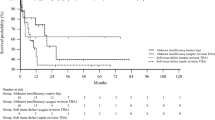Summary. Between January 1991 and May 1994, 11 patients with chronic recalcitrant infection of the hip joint were successfully treated by transposition of a vastus lateralis flap. The average duration of the infection was 7.9 months. The patients had undergone an average of 2.8 procedures in an attempt to eradicate the infection before transposition of the flap. Three patients had recurrence of drainage after the procedure and were successfully treated with antibiotics and local debridement. Delayed exchange total hip arthroplasty was performed in 2 patients. All the patients achieved wound healing and infection resolution. This flap has several advantages. The donor site has not usually been scarred from previous operations; the flap has a consistent vascular pedicle which permits a wide arc of rotation; knee extension is unaffected; the transposed portion of the vastus lateralis can act as a cushion between the acetabulum and the proximal femur; it may also act as a tether to prevent extreme proximal migration of the femur. In the management of chronic recalcitrant infection of the hip, use of a transposition flap can be combined with a Girdlestone arthroplasty. It can also be an interim procedure before a further total joint arthroplasty.
Résumé. Entre Juin 1991 et Mai 1994, 11 patients souffrant d’une infection chronique persistante de la hanche ont pu être traités avec succès à l’aide d’une transposition du vaste externe. La durée moyenne d’infection était de 7,9 mois. Les patients avaient subi, en moyenne 2,8 tentatives chirurgicales d’éradication de l’infection avant que ne soit pratiquée la transposition musculaire. Trois patients ont eu une récidive de fistule traitée avec succès par antibiotiques et débridement local. Chez 2 patients, a été fait un remplacement prothétique dans un temps chirurgical ultérieur. Au dernier examen, chez tous les patients, la cicatrisation était obtenue et les problèmes d’infection résolus. Les avantages de la technique utilisée sont les suivants: l’intégrité du muscle est en générale respectée par les opérations précédentes et il possède un pédicule vasculaire permettant un large arc de rotation; il peut faire office de tampon entre l’acétabulum et le fémur voisin et d’attache pour prévenir une migration proximale extrême du fémur. Enfin, la fonction d’extension du genou semble n’être en rien entravée. Dans le traitement d’une infection chronique persistante de la hanche, l’utilisation de ce type de transposition non seulement peut servir de procédé d’appoint à l’arthroplastie de Girdlestone mais peut faire également office de temps intermédiaire avant une arthroplastie totale ultérieure.
Similar content being viewed by others
Author information
Authors and Affiliations
Additional information
Accepted: 10 May 1996
Rights and permissions
About this article
Cite this article
Lee, S., Ueng, SN. & Shih, CH. Vastus lateralis flaps for chronic recalcitrant hip infection. International Orthopaedics SICOT 20, 373–377 (1997). https://doi.org/10.1007/s002640050101
Issue Date:
DOI: https://doi.org/10.1007/s002640050101




